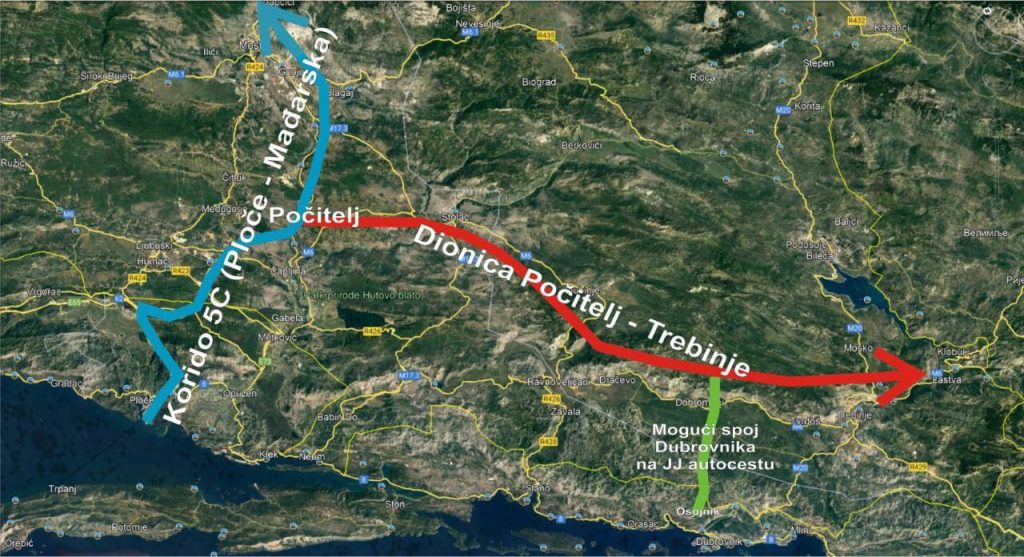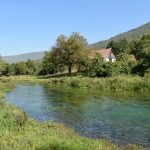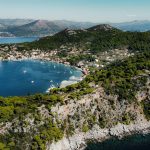While there is euphoria in Croatia about the imminent launch of the Peljesac Bridge, the first neighborhood Public Company, FBiH Motorways, has just announced a public call for a preliminary and main project of the Adriatic-Ionian Corridor, section Stolac – Interregional junction Pocitelj, about 23 kilometers long, reports Dubrovacki Vjesnik.
This news would not be so crucial for Croatia if it did not lead to a new possible traffic (dis)connectivity problem for Dubrovnik-Neretva County. And it has people wondering if Pocitelj is becoming the central hub from Trieste to Greece, and the new Peljesac bridge just a local bypass?
After 20 years of waiting for the road junction, no one on this side of the border wants to think that the Peljesac Bridge and access roads could ‘lose out’ if the regional branch of the Adriatic-Ionian highway goes through the hinterland, from Pocitelj to the endpoint Aranđelovo near Trebinje on the Montenegro border and completely bypasses Croatian territory.
So far, the Adriatic-Ionian traffic route has been talked about as a benefit for the traffic-isolated south, primarily due to the completion of the Peljesac Bridge and the expected passage of the highway through the Neum area.
Whether our largest infrastructure project will fit into this mold should be more apparent after March 15, when the deadline for applications from contractors interested in building the Stolac-Pocitelj section expires. The contractual value of the documentation is estimated at 6 million convertible marks without VAT, and the planned completion date is 18 months. The designers see the beginning of the route in Pocitelj as a connection with the Pan-European Corridor Vc (from Venice to Kyiv). In addition to Stolac and Capljina, it would include Ravno, Ljubinje, Trebinje, and further towards Montenegro, without a visible connection with Croatia.
However, in Croatian professional and political circles, they do not believe that the Peljesac Bridge will remain marginalized on the future road route.
On the topic of road construction in the hinterland, Dubrovnik-Neretva County Prefect Nikola Dobroslavić points out:
“Each state is thinking about how to connect its territory, so we do not want to comment on these intentions and moves of our neighboring BiH and the Federation of BiH. As for the Republic of Croatia, it is planned to connect the extreme south of Croatia by highway from the Metkovic junction to Osojnik with an exit to BiH (as part of the Adriatic-Ionian highway), the expressway Zračna Luka – Dubrovnik – Osojnik, and the expressway Brijesta – Perna. This is stated in Croatia’s National Development Strategy and all spatial plans of Dubrovnik-Neretva County and supported by the conclusions of the Government at the session in Dubrovnik in 2019,” said Dobroslavić and reminded that for all the listed planned roads, study documentation is being prepared from Hrvatske ceste, i.e., Hrvatske autoceste, and realization is expected.
Last year, at the seminar of the Croatian Engineering Association and the Society of Civil Engineers in Zagreb, Dobroslavić reiterated that the position of Dubrovnik-Neretva County has always been to connect the extreme south of Croatia to the motorway network as strongly as possible.
“We must do it quickly to benefit our fellow citizens and tourists, but these are, let’s not forget, geostrategic solutions for the Republic of Croatia. We see instabilities around us, and we need to think about ourselves and our security. Therefore, the only possible connection of Croatia is by a highway, which in our opinion should be the Adriatic-Ionian highway that passes through Dubrovnik-Neretva County,” said Dobroslavić.
The position of the Ministry of the Sea, Transport and Infrastructure in the field of road construction towards the southernmost county is also unequivocal:
“Southern Croatia must be connected by highway after constructing the Peljesac Bridge. Therefore, this part of Croatia deserves to be the largest construction site in the road segment. Apart from the Peljesac Bridge and the highway to Dubrovnik, one of the biggest segments must be the connection of Dubrovnik Airport with the City of Dubrovnik. We are also planning to reconstruct the Peljesac road with the Orebic bypass with a new ferry port in Orebic,” said the State Secretary at the Ministry Tomislav Mihotić last autumn at the same meeting in Dubrovnik.
Croatian Motorways, meanwhile, has intensified talks on building 47 kilometers of motorways with another 14.7 kilometers of connecting roads from the Metkovic junction to the Dubrovnik (Osojnik) junction at the cost of 1.2 billion kuna.
The highway project from Metkovic to Dubrovnik was divided into two sections. The first section is the Metkovic – Peljesac junction – Duboka junction, about 22 kilometers long, which includes the construction of 17.5 kilometers of motorways from Metkovic to the Peljesac junction and 4.45 km of highway from the Peljesac junction to the Duboka junction.
The second section would go from the Rudine junction to the Osojnik junction and include the fast road from the Ston junction to the Doli junction (5.5 km) and the connecting road Slano junction to DC8 (4.7 km). The motorway section from the Rudine junction to the Osojnik junction is 29.5 kilometers long and includes constructing a connection between the Rudine junction and the existing road network.
According to HAC, these two motorway sections will continue on the access highways on Peljesac and the Peljesac bridge.
However, domestic road construction experts find it difficult and reluctant to talk about projections for the future because they have repeatedly proved ungrateful. However, it is enough for the layman to remember that the complete profile of the highway includes four lanes, which is not feasible due to the narrowed territory in the extreme south. It isn’t easy to go with much narrower roads.
Minister of Transport Oleg Butkovic commented on his visit to the City of Dubrovnik two years ago about the strategic project of the expressway to the Dubrovnik Airport and explained why everything still stands:
“We are currently investing 6.7 billion kuna in transport infrastructure; these are large infrastructure projects. We cannot do all projects at the same time. The project is announced, and we will make it when the project and study documentation is ready, done, and finished, and it will be a candidate for the next operational period. We are completing the Peljesac Bridge, the Airport, and of these big projects, this will be the next one we will work on. There will be no problems; the expressway will relieve the state road. The D8 road is congested, and there must be a relief,” said Butković.
For more news in Croatia, follow TCN’s dedicated page.











